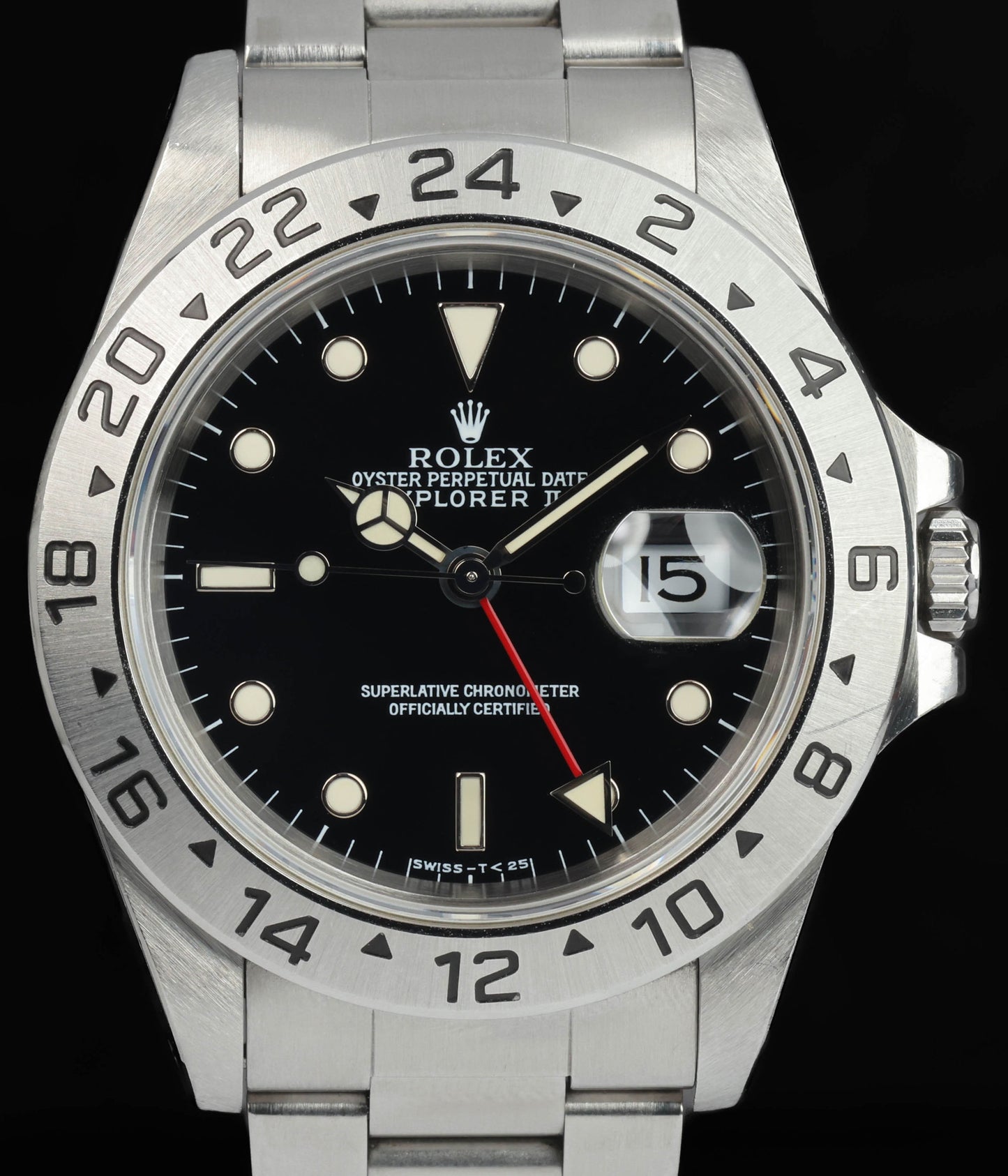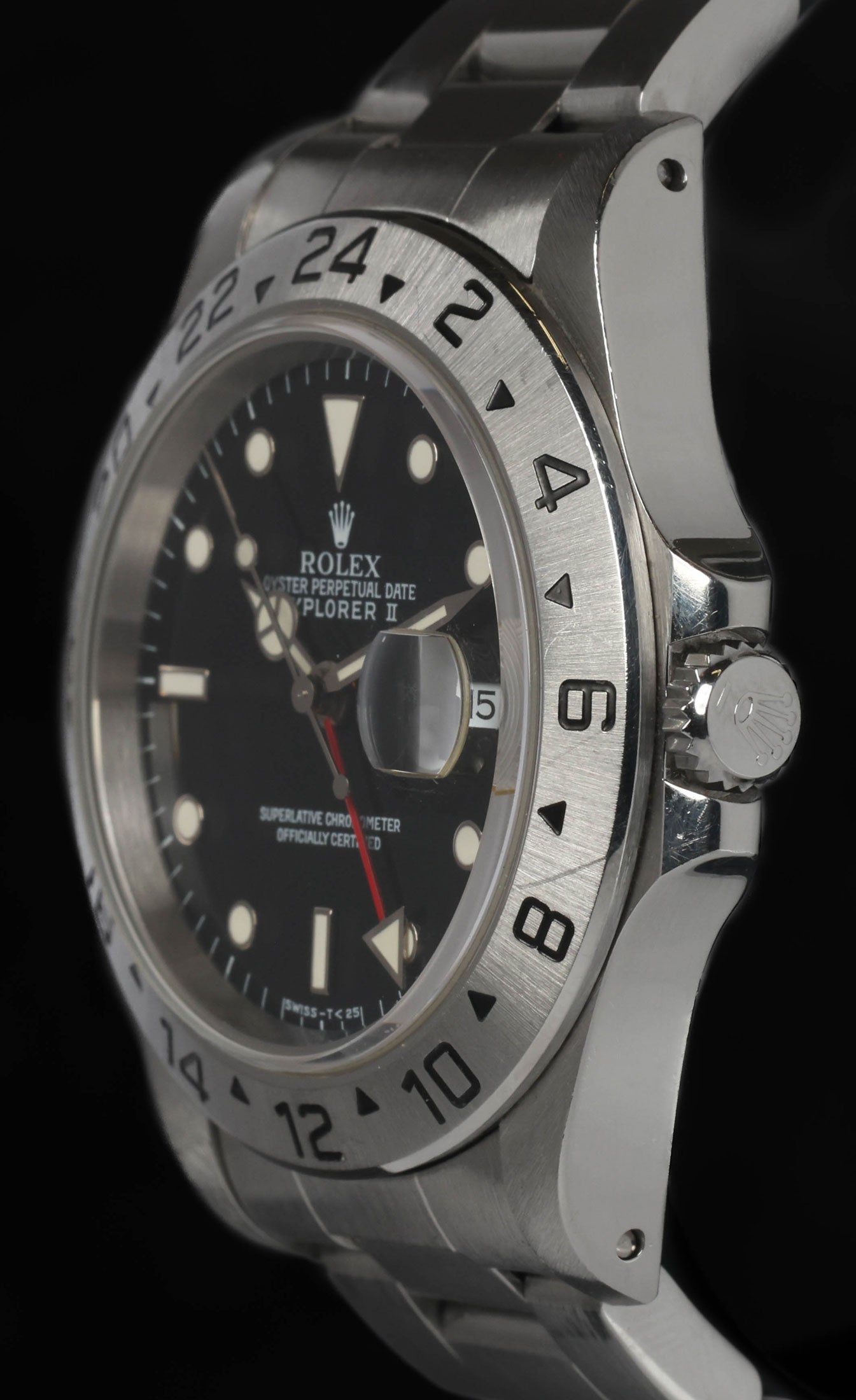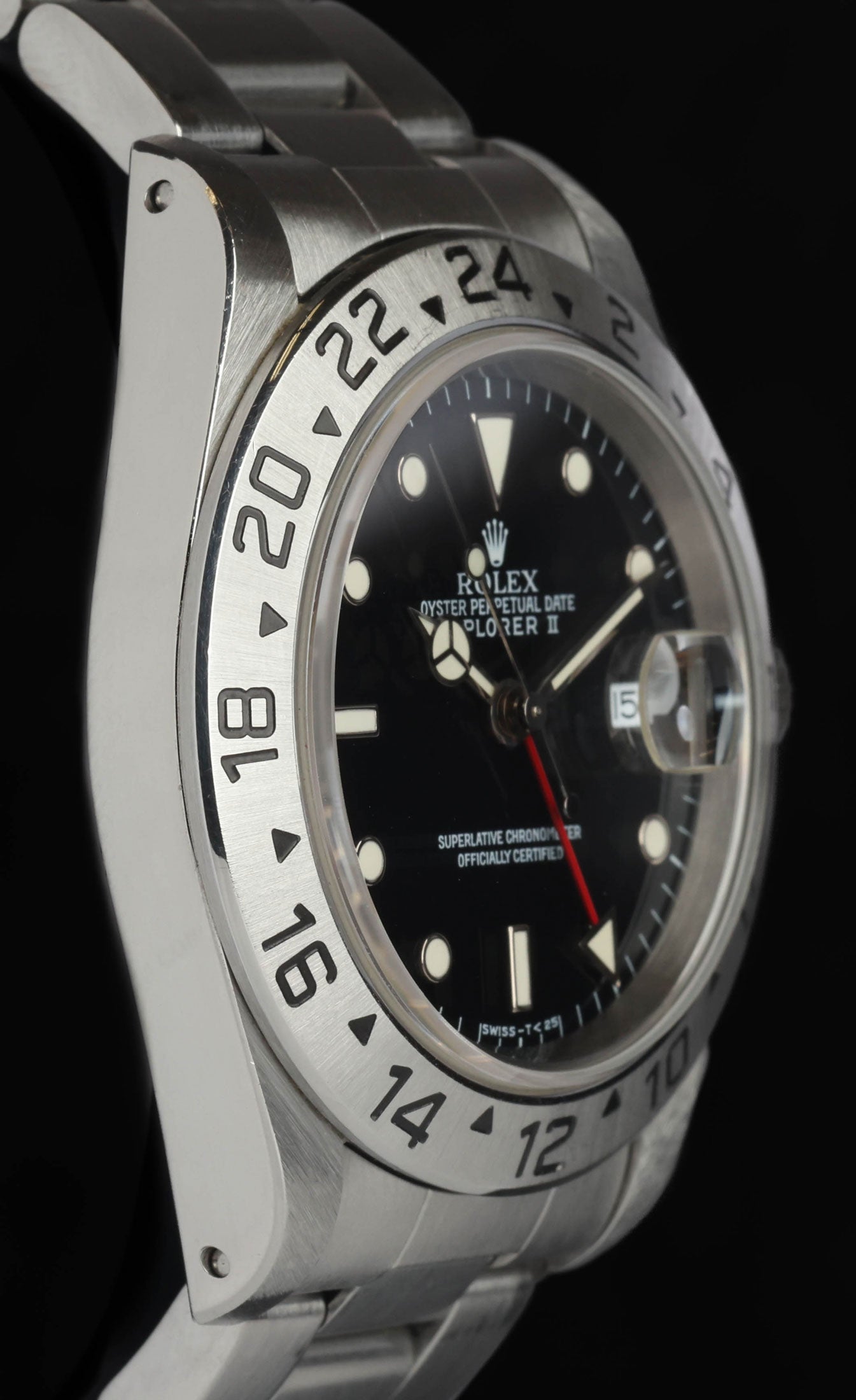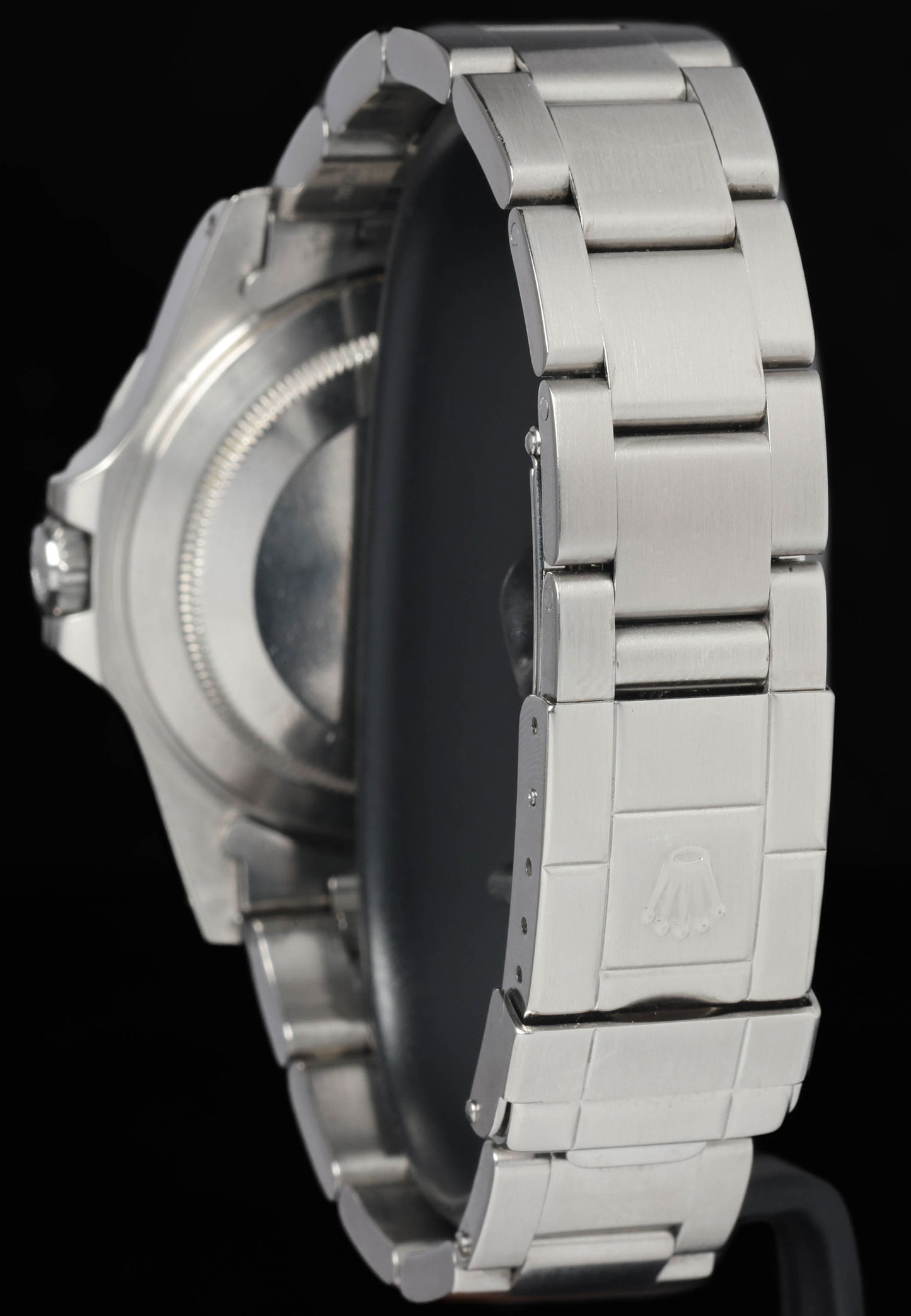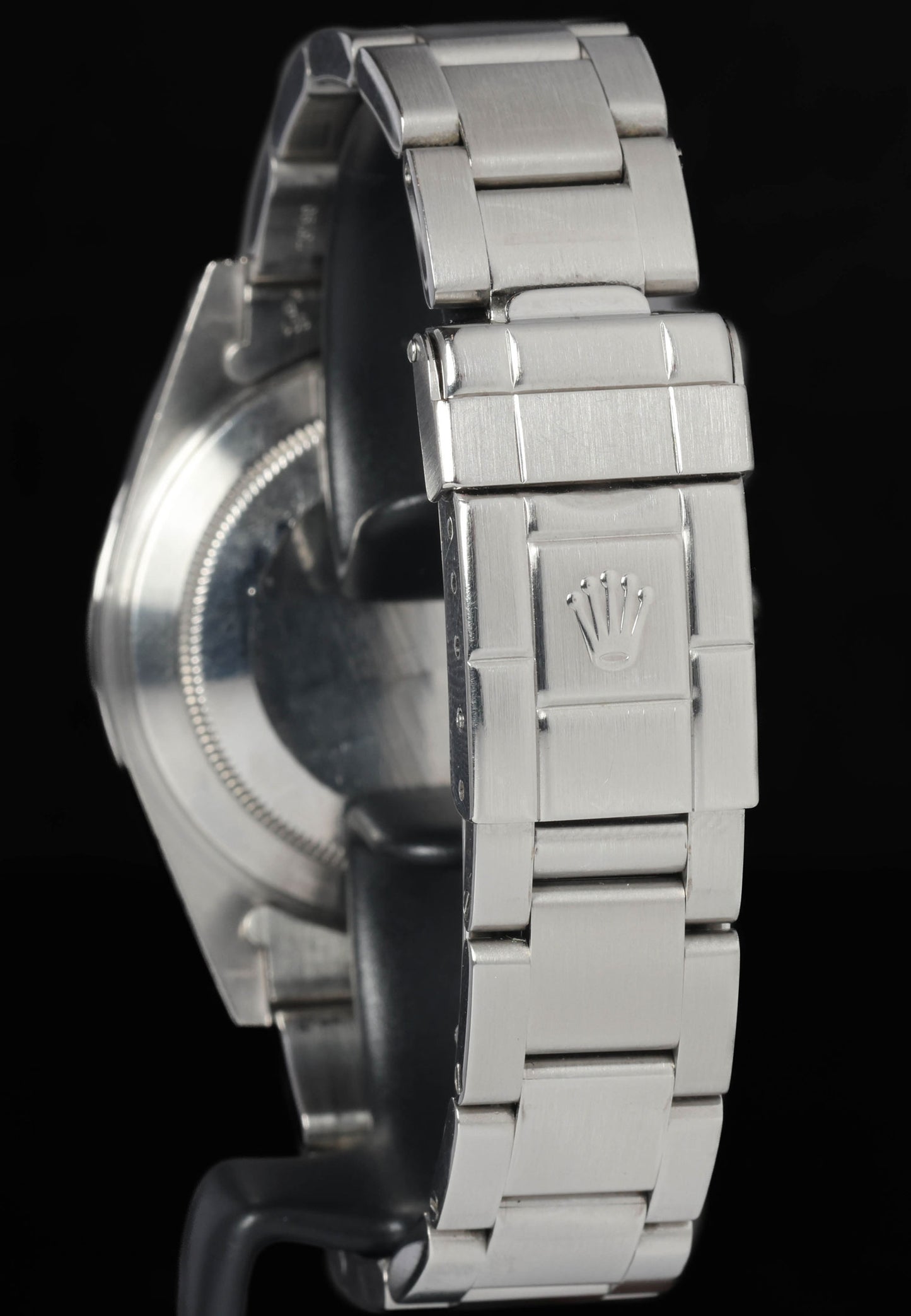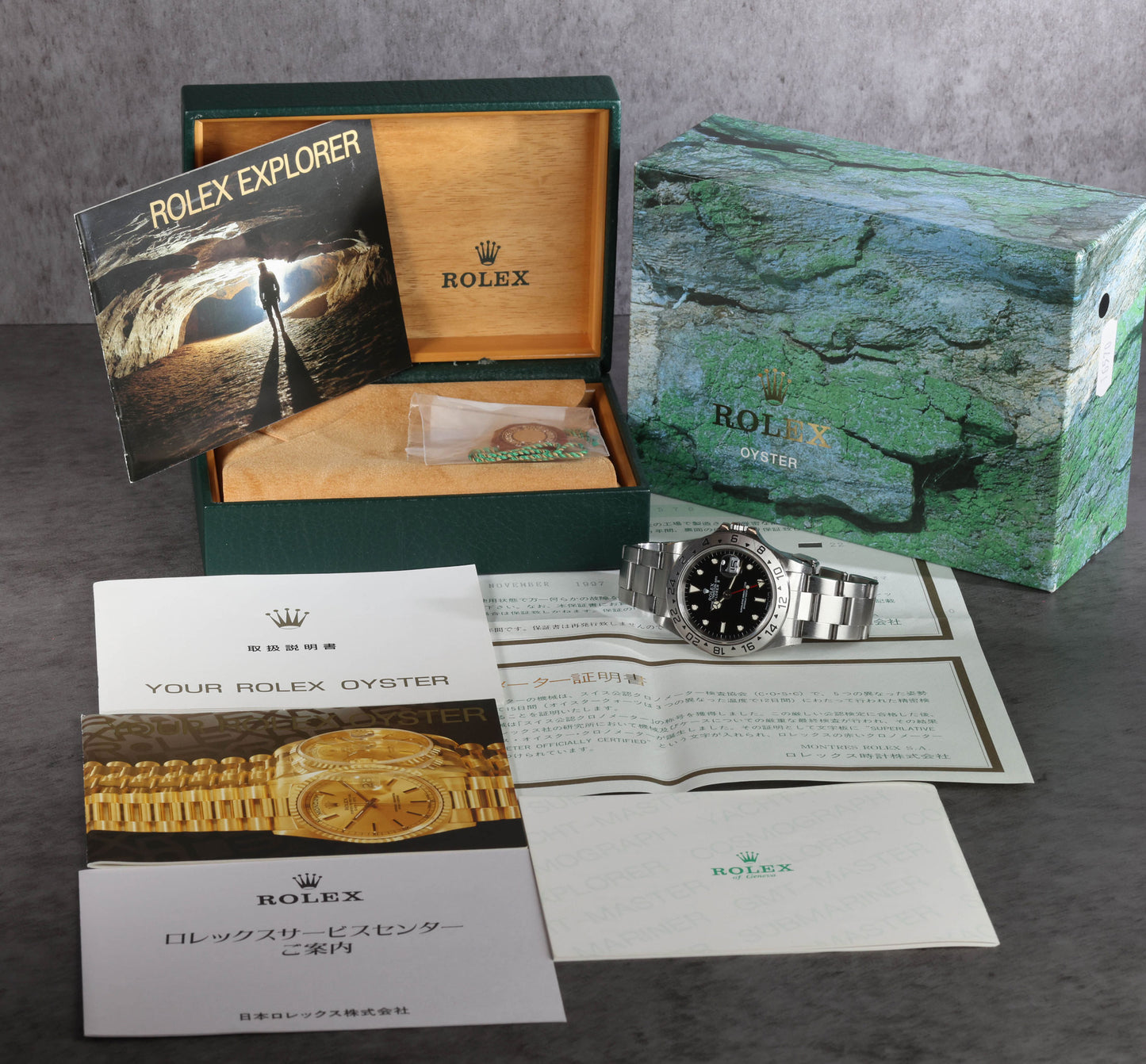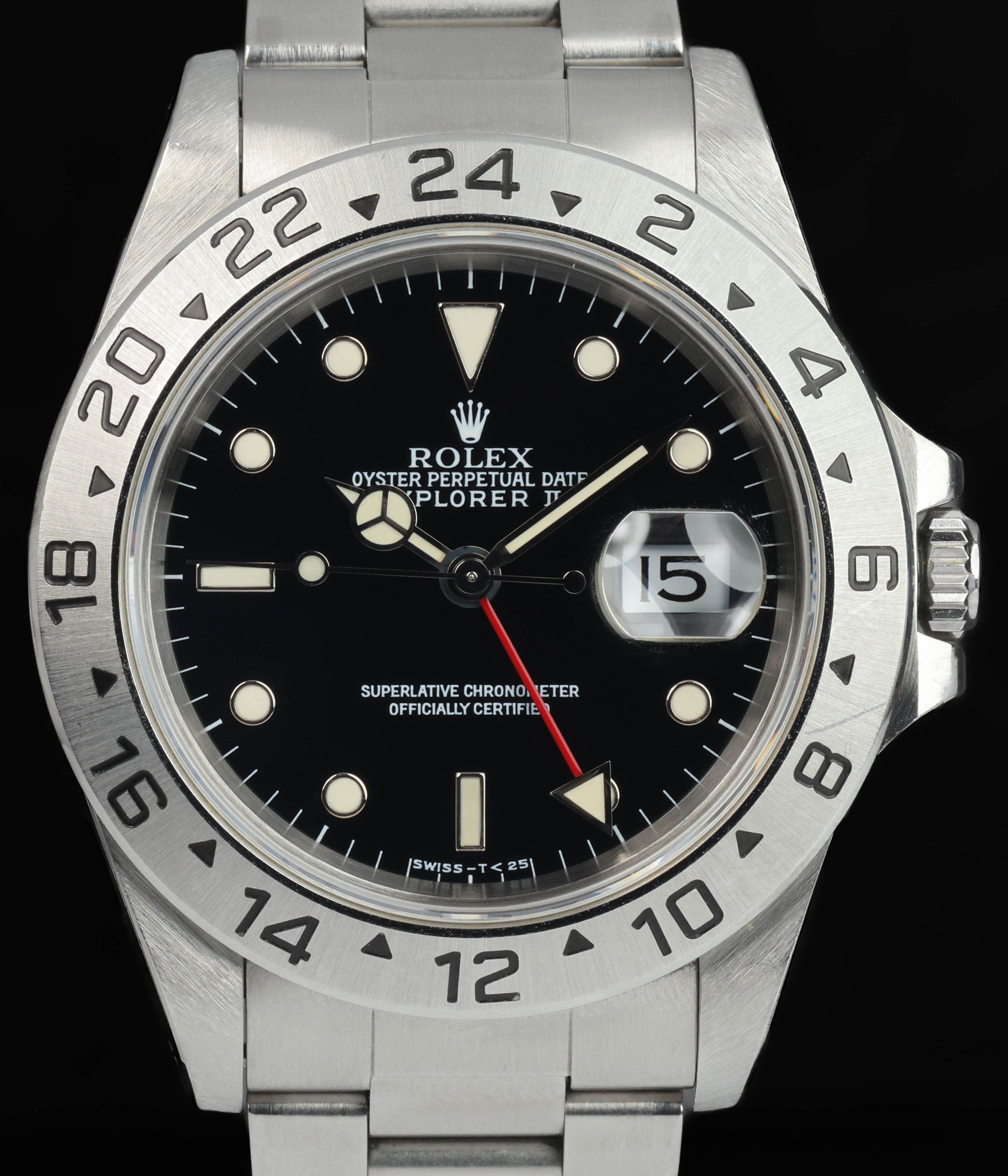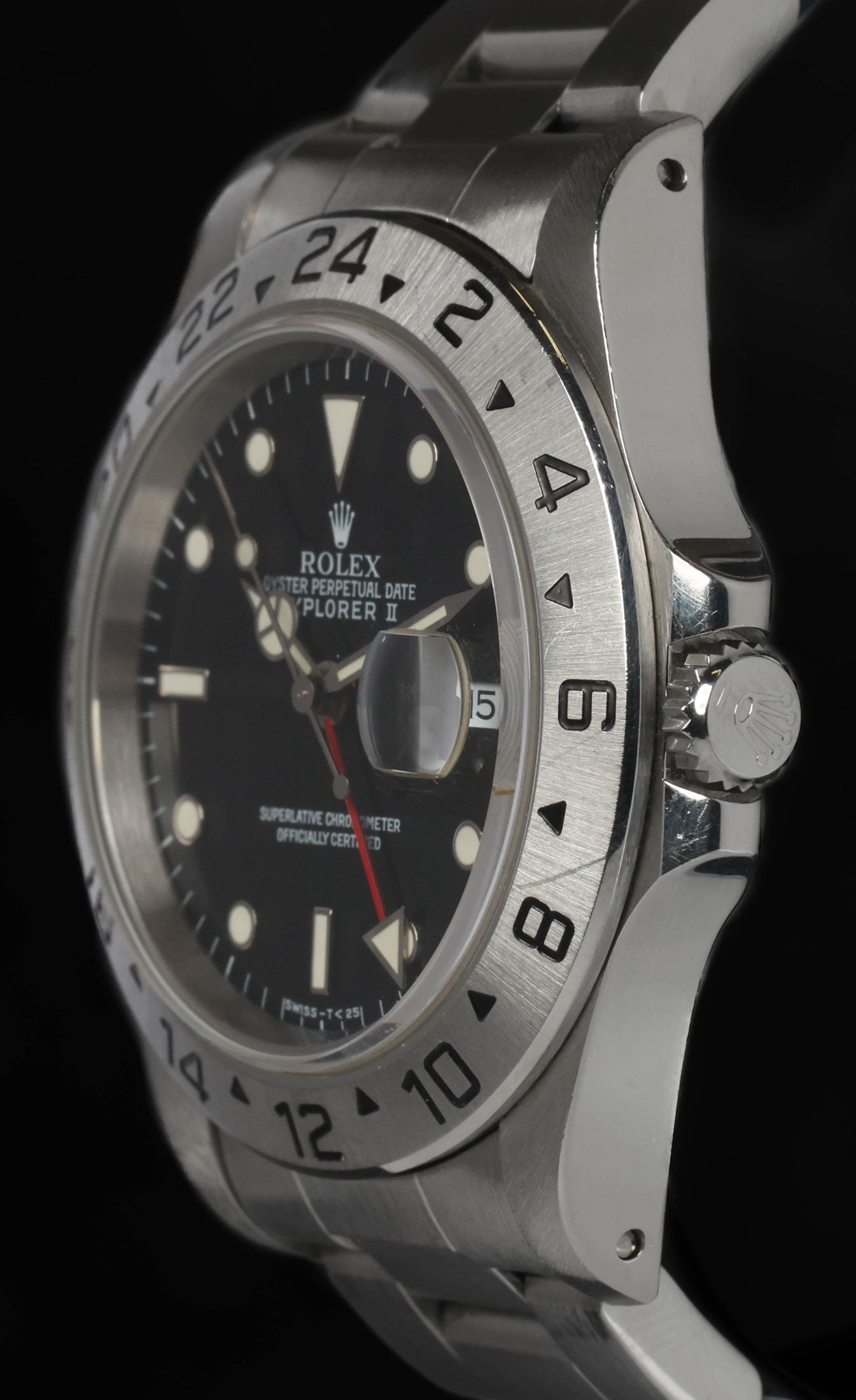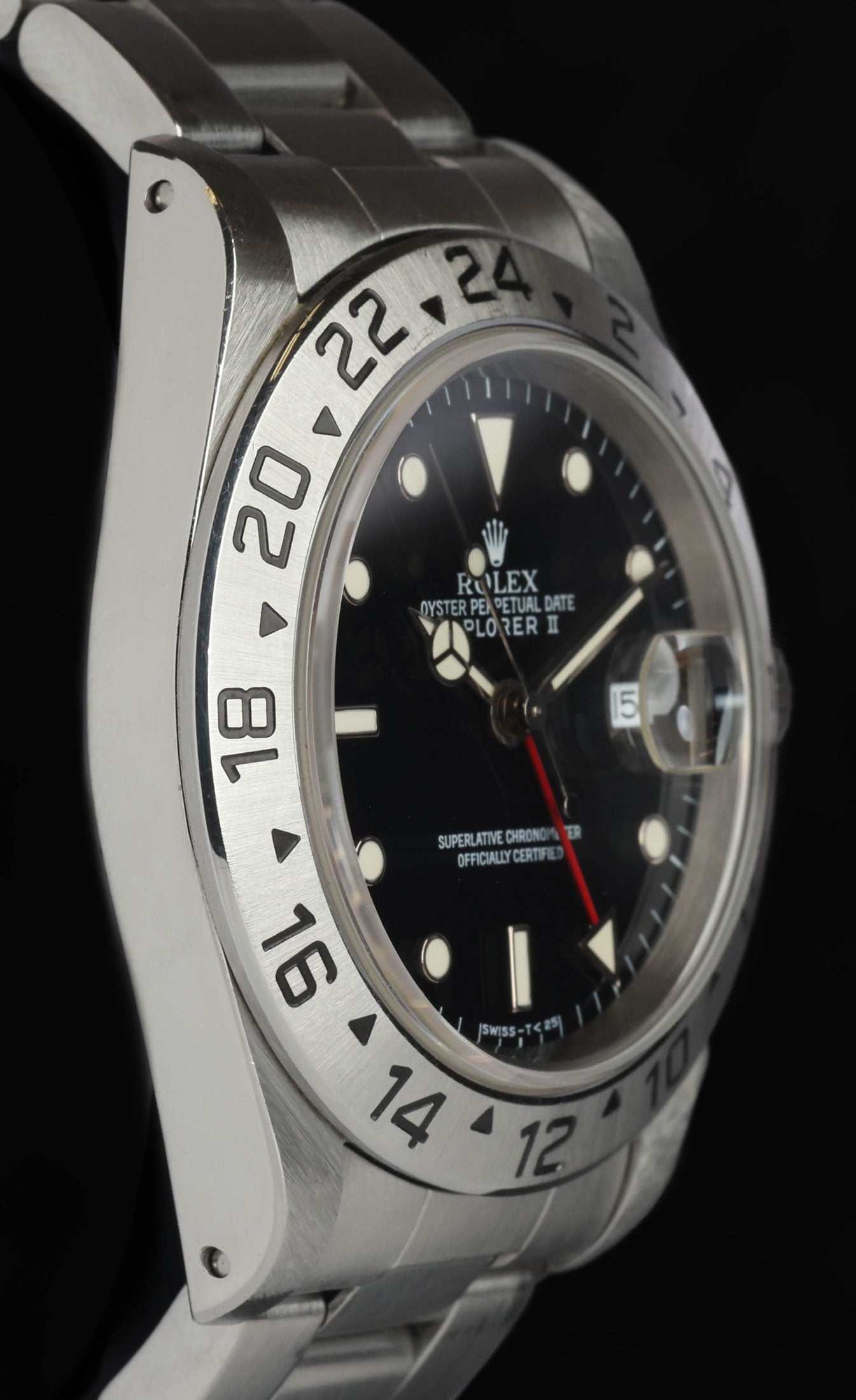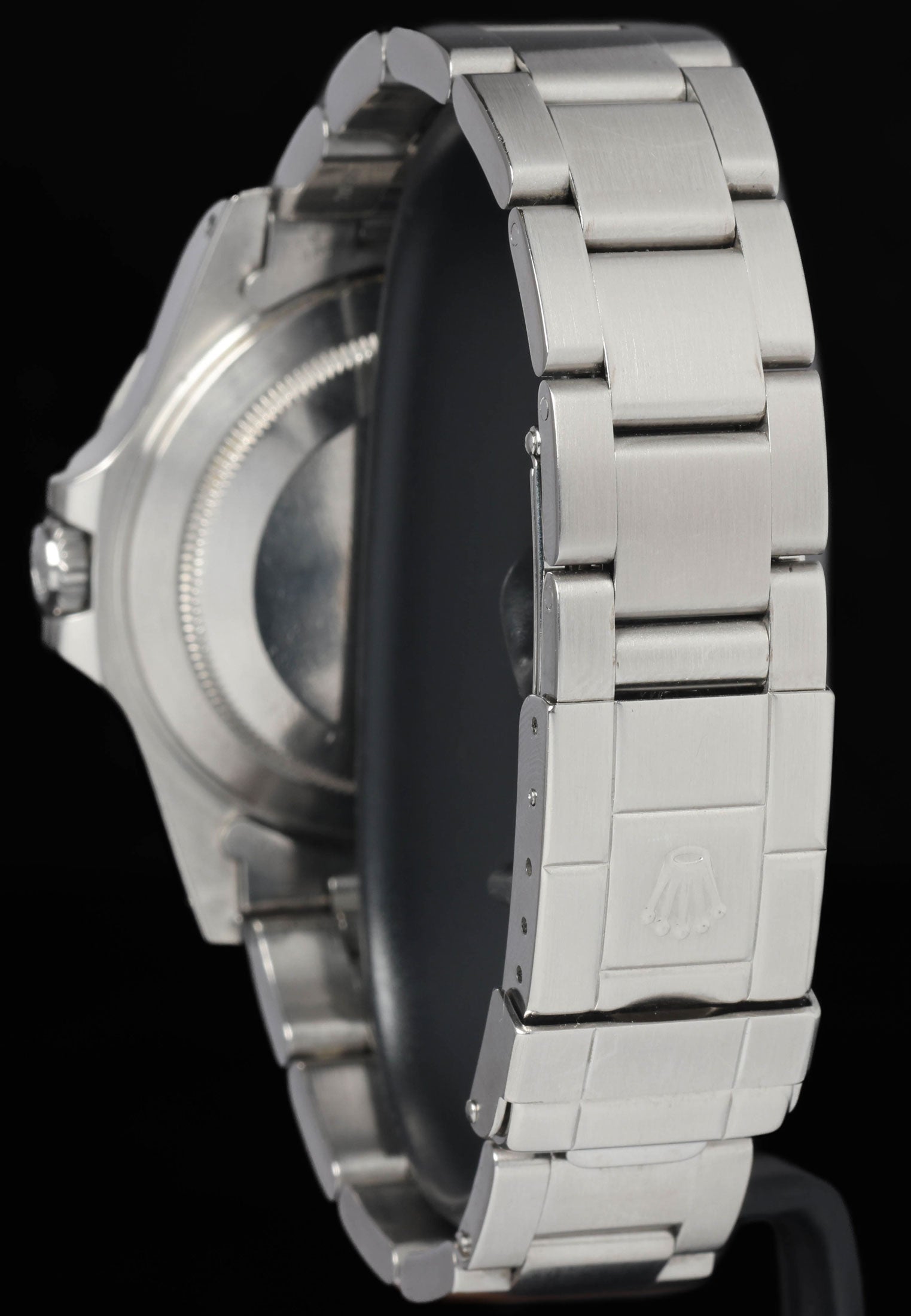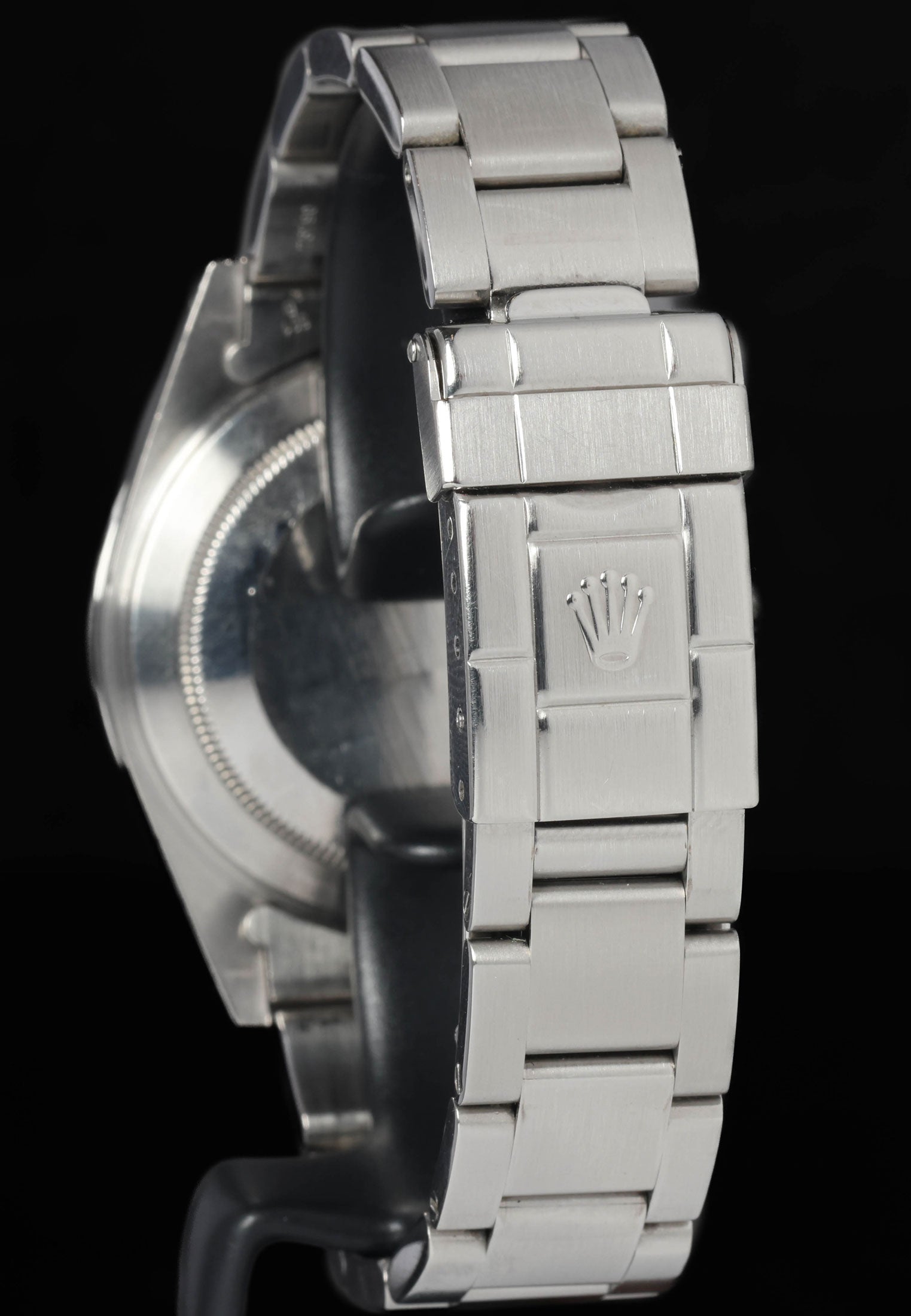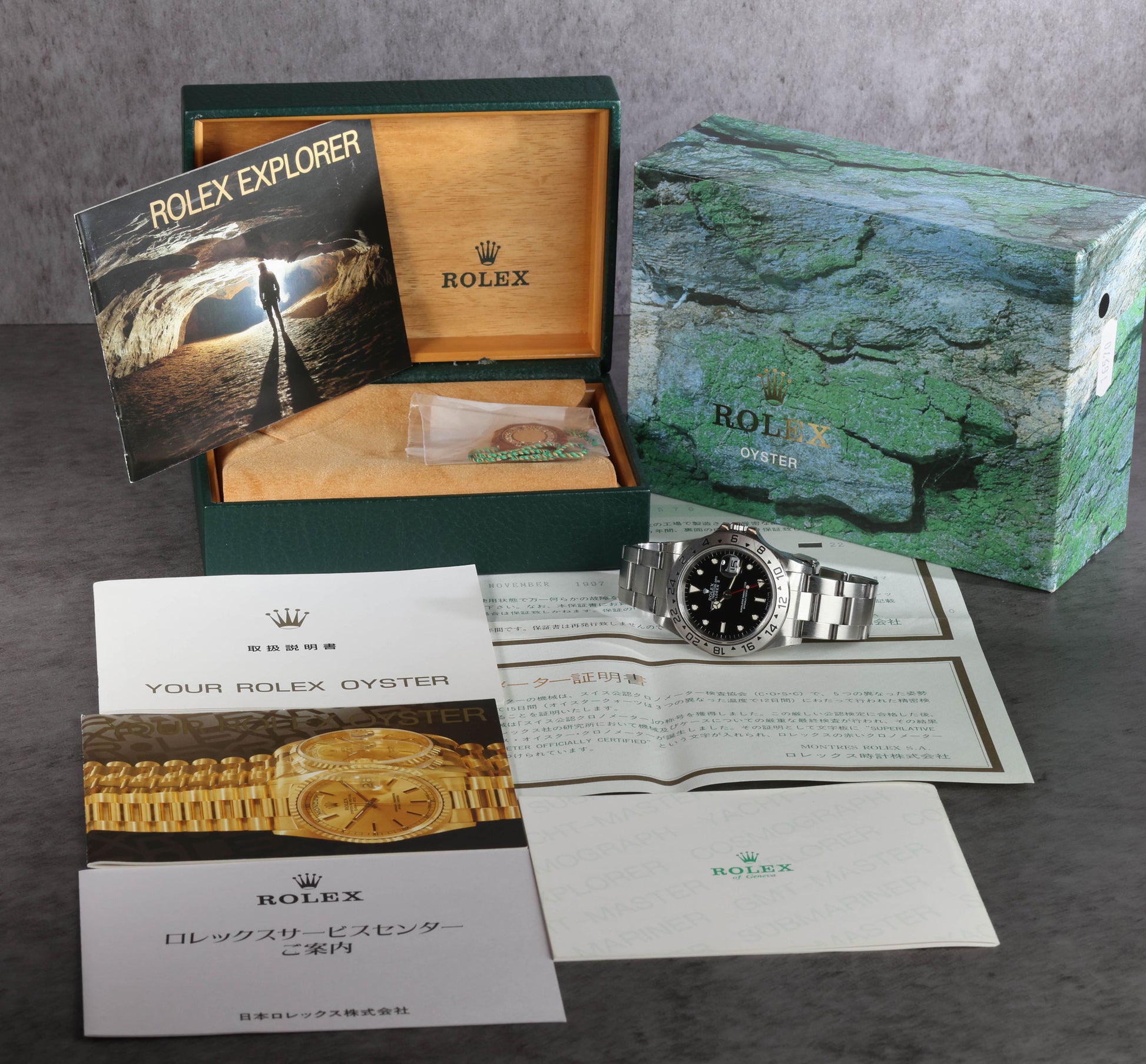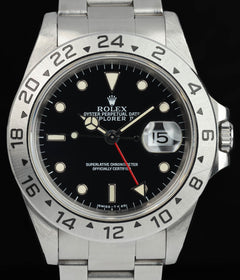Crown Vintage
Rolex Explorer II 'Black' 16570 40mm 1997 Box and Papers
Rolex Explorer II 'Black' 16570 40mm 1997 Box and Papers
Couldn't load pickup availability
Rolex Explorer II 'Black' 16570
The stainless-steel case is in very good condition with sharp, unpolished lugs. Factory brushing and original chamfers are visible and intact, with only light hairlines from careful wear; no dents or deep marks seen under angled light.
The dial is in excellent condition with a light, even patina that enhances legibility; all printed text is crisp and uniform, and the overall tone is consistent across the display.
The bezel remains unpolished and presents very well, with clean edges and legible markings; only minor surface marks visible on close inspection.
Bracelet great with minimal wear and stretch; smooth articulation, tight end-links, secure clasp.Dial excellent with a light, even patina; crisp, uniform printing.
Share
Why we love this watch
Why we love this watch
Rolex Explorer II: An Expanded Historical Perspective
Origins: From Darkness to Daylight (1971–1974)
The Explorer II emerged in 1971 as reference 1655, a watch conceived for professionals who operated where ordinary daylight cues disappeared—speleologists mapping cave systems, Arctic researchers enduring months of continuous sun, and deep-mine geologists. Rolex solved their time-orientation problem by fixing a 24-hour bezel to a steel Oyster case and adding a bright orange arrow hand geared to circle the dial once per day. With bezel and hand locked together, wearers could distinguish AM from PM at a glance, even in pitch black or relentless midday sun.
Unlike the original Explorer I, which took its name from Himalayan mountaineering exploits, the 1655 served a narrower technical brief. Its busy dial, minute-track hash marks and static bezel set it apart from the better-known GMT-Master, whose rotating insert offered three-zone flexibility for airline pilots. The Explorer II was instead the specialist’s instrument: purposeful, legible and tuned to a single environmental challenge. Production ran only until 1984, leaving relatively few in circulation and cementing the 1655’s reputation among collectors.
Transitional Years and Modernisation (1985–1988)
Rolex revisited the concept in 1985 with reference 16550. The watch retained the 40 mm footprint but looked far more contemporary: sapphire crystal replaced acrylic, calibre 3085 introduced independent jumping of the 12-hour hand, and the dial was offered in black or white—the first appearance of the now-famous “Polar” colourway. The fixed bezel’s font was enlarged and cleaned up, improving readability at a glance.
In hindsight the 16550 acted as a bridge. Rolex’s experimental white paint batches occasionally aged into a pleasing cream tone, while black dials suffered spider-web cracking under certain temperatures. Those quirks led Rolex to move quickly to the next reference, but they also gave the 16550 a brief, distinctive personality that still intrigues enthusiasts today.
Consolidation and Long Production: Reference 16570 (1989–2011)
Launched in 1989, the 16570 became the definitive Explorer II for more than two decades. It shared the same 40 mm case as its predecessor yet remedied dial-paint and crystal issues, standardised on the high-beat calibre 3185, and gradually adopted incremental improvements such as solid bracelets and, later, calibre 3186 with a Parachrom hairspring.
Early examples (1989-1997) used tritium lume and drilled lug holes, giving them a distinctly vintage flavour. Late 1998 ushered in Luminova, and for roughly two years the dial read simply SWISS at six o’clock—an easy visual cue for watches made in 1999. Later models switched to the familiar SWISS MADE line, phased out lug holes, adopted solid end links and, eventually, gained the updated 3186 movement.
Throughout this period the Explorer II remained relatively understated compared with the Submariner and GMT-Master II, a fact that kept prices accessible and ensured the model found genuine working-tool owners: Antarctic field teams, mining engineers and commercial surveyors who valued clarity and shock resistance over luxury signalling.
Up-Sizing for a New Era: Reference 216570 (2011–2021)
For the Explorer II’s fortieth anniversary Rolex departed from the long-serving 40 mm template. Reference 216570 grew to 42 mm, reintroduced the oversized orange arrow hand as a nod to the 1655, and debuted the calibre 3187 with Paraflex shock absorbers. Chromalight lume replaced Super-Luminova, glowing ice-blue instead of green.
While these updates met modern tastes for larger cases, they also marked a philosophical shift. The Explorer II was no longer the discreet specialist; it now stood shoulder-to-shoulder with Rolex’s higher-profile sports models, backed by advertising that emphasised polar exploration and high-altitude rescue rather than subterranean mapping.
The Contemporary Iteration: Reference 226570 (2021–present)
To celebrate the model’s fiftieth year, Rolex refined rather than reinvented the Explorer II. It remained 42 mm but adopted slimmer lugs, a slightly thinner case profile and the calibre 3285 with a 70-hour power reserve. The fixed bezel returned to a crisper font, and subtle dial tweaks improved contrast without altering the familiar polar-versus-black choice. In effect, the 226570 consolidated the lessons of the previous decade, offering modern movement technology while tempering visual bulk.
Five Constant Design Pillars Across All Generations
- Fixed 24-hour bezel – Prevents accidental mis-setting in gloves or darkness.
- Twin-hand architecture – Local 12-hour hand plus independently set 24-hour hand give instant day-night or second-time-zone reading.
- Oyster case construction – Screw-down crown and back yield at least 100 m water resistance, crucial for ice-field crews and wet cave systems.
- High-contrast dial markings – Large indices and broad hands prioritise legibility ahead of ornament.
- Steel-only ethos – Until very recently, Rolex never produced an Explorer II in precious metal, underscoring the model’s utilitarian core.
Why the Explorer II Stayed Niche for So Long
Rolex’s own catalogue positioned the Explorer II below the Submariner and GMT-Master in glamour yet above the Air-King and Explorer I in complexity. That middle ground gave it a dedicated but modest following. On the secondary market the watch was often a sleeper, purchased by professionals who needed its function rather than by collectors chasing status. Only in the past decade has wider enthusiasm grown, as enthusiasts realised that long production runs mask subtle, year-by-year changes—tritium versus Luminova, lug-hole versus no-hole, 3185 versus 3186—that reward deep study.
Legacy and Influence
While the Explorer II never starred in as many films or celebrity photo-ops as the Daytona, it influenced the broader sports-watch landscape in quieter ways. Brands ranging from Sinn to Tudor have adopted fixed 24-hour bezels paired with bright GMT hands, targeting the same audience of adventurers who value absolute reliability over convertible multi-scale systems. Meanwhile, Rolex’s steadfast refusal to gild the Explorer II with precious metals until a 2023 yellow-gold variant emphasises the model’s role as the brand’s last all-steel expedition tool.
Final thoughts
Across five decades the Explorer II has moved from a single-purpose cave companion to a versatile dual-time sports watch, evolving through careful, incremental engineering rather than sweeping redesigns. Its fixed bezel, dual-hand layout and steel-only discipline speak to Rolex’s original brief: deliver absolute legibility and durability where daylight fails. Whether you pick a 1970s 1655 for its quirky dial, a 1999 Luminova 16570 for its balanced charm, or a modern 226570 for its extended power reserve, each Explorer II remains anchored to a mission that prioritises function over flash—a design philosophy that continues to resonate with wearers who value true utility.
Case & Bracelet
Case & Bracelet
Case in very good condition. Sharp, unpolished lugs. Factory brushing and Chamfers visible and intact. Bracelet in great condition. Minimal wear and stretch visible. Bezel unpolished.
Dial & Hands
Dial & Hands
Excellent condition. Light patina.
Warranty & Condition
Warranty & Condition
Crown Vintage Watches provides a minimum 3-month mechanical warranty on pre-owned watches, from the date of purchase.
The warranty covers mechanical defects only.
The warranty does not cover damages such as scratches, finish, crystals, glass, straps (leather, fabric or rubber damage due to wear and tear), damage resulting from wear under conditions exceeding the watch manufacturer’s water resistance limitations, and damage due to physical and or accidental abuse.
Please note, water resistance is neither tested nor guaranteed.
Shipping and insurance costs for warranty returns to us must be covered by the customer. Returns must be shipped via traceable courier. Return shipment must be pre-paid and fully insured. Collect shipping will be refused. In case of loss or damages, the customer is liable.
Our Pledge
At Crown Vintage Watches, we stand by the authenticity of every product we sell. For added peace of mind, customers are welcome to have items independently authenticated at their own expense.
Condition
Due to the nature of vintage timepieces, all watches are sold as is. We will accurately describe the current condition and working order of all watches we sell to the best of our ability.
Shipping & Refund
Shipping & Refund
